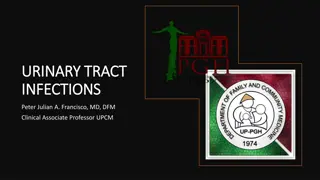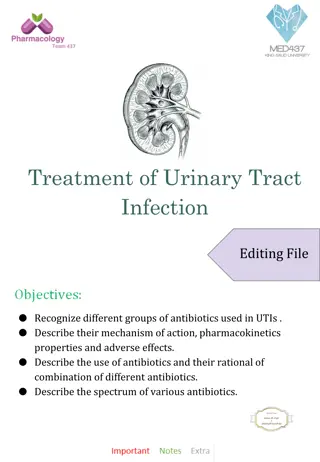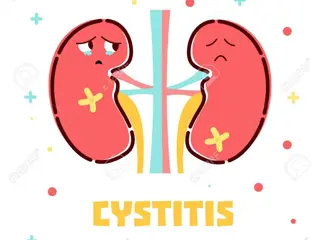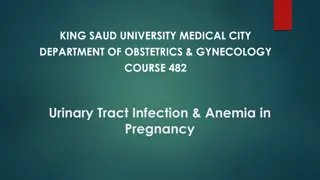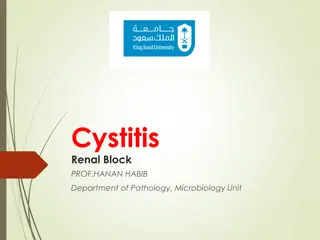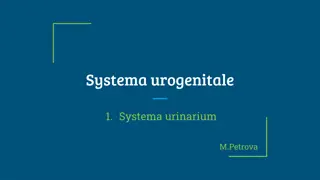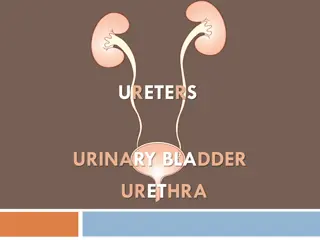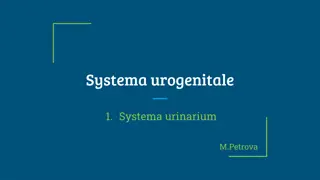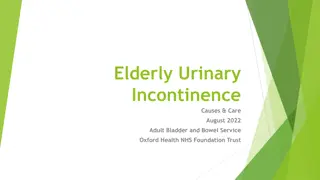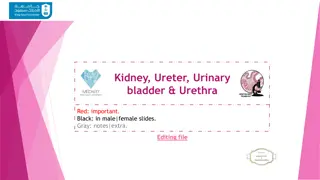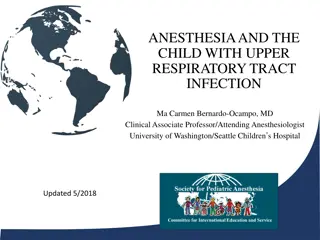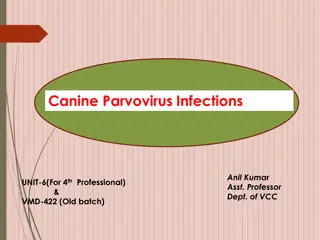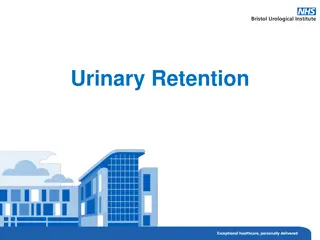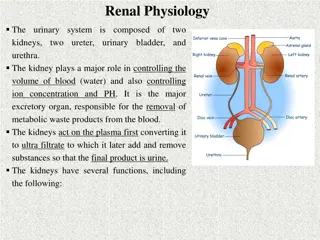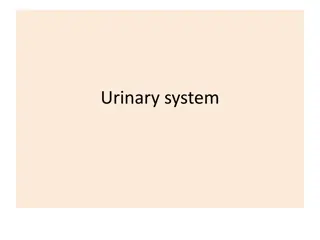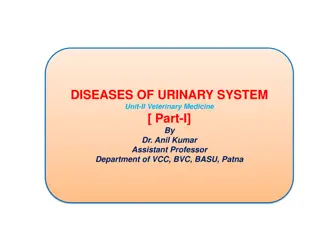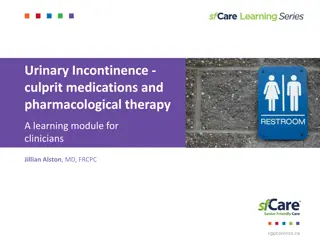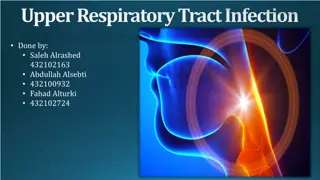Management of Urinary Tract Infection: Important Notes and Guidelines
Understanding the management of urinary tract infections (UTI) is crucial for healthcare professionals. The main goal is to eradicate offending organisms using antibiotics, which vary based on factors like infection type and patient profile. Treatment duration and antibiotic choices differ for relapsing infections, uncomplicated UTIs, and recurrent cases. Prophylactic measures, postcoital antibiotics, and preventive therapy play key roles in managing UTIs, especially in high-risk patients. Proper management helps prevent complications and recurrence, ensuring optimal patient outcomes.
Download Presentation

Please find below an Image/Link to download the presentation.
The content on the website is provided AS IS for your information and personal use only. It may not be sold, licensed, or shared on other websites without obtaining consent from the author. Download presentation by click this link. If you encounter any issues during the download, it is possible that the publisher has removed the file from their server.
E N D
Presentation Transcript
Lecture : management of UTI important Extra notes Doctors notes " . "
Objectives: 1- Know the principal goal of management of urinary tract infection (UTI) 2- Understand that management of UTI depends on several factors . 3-Know that antibiotics are the main treatment of UTI. 4- Know the management/treatment of different conditions of UTI ( cystitis, pyelonephritis, catheter associated UTI ,etc.)
Goal of Management of UTI The principal goal of management of UTI is to eradicate* the offending organisms from the urinary bladder and tissues. The main treatment of UTI is by antibiotics. Choice of antibiotic depends on: Whether infection is complicated or uncomplicated. Whether infection is primary or recurrent. Type of patient ( pregnant ,child , hospitalized or not, diabetic patient, ..etc) Bacterial count. Presence of symptoms. When to consult the doctor ? If symptoms persist A change in symptoms (fever or hematuria) Pregnant women More than 4 infections per year Impaired immune system (such as diabetes) Previous kidney infections (as pyelonephritis) Structural abnormalities of urinary tract History of infection with antibiotic resistant bacteria. * You decide the treatment according to the situation of the patient not the organism
Relapsing infection: Caused by treatment failure or structural abnormalities or abscesses. Antibiotics used at the initial infection Treatment for 7-14 days. we have to treat the cause of relapsing then give the suitable antibiotic Uncomplicated UTI Low-risk patient (woman) for recurrent infection: 3 days antibiotic without urine test. Cure rate 94%. Choice of antibiotic depend on susceptibility pattern of bacteria, it includes : Amoxicillin ( with or without clavulanic acid) Cephlosporins ( first or second generation) first as cephalexin, second as cefuroxime Fluoroquinolone ( ciprofloxacin or norfloxacin) (not for pregnant women or children) / first choice if other antibiotics are resistant. TMP-SMX ( trade names (another names): Bactrim, Septra ,Cotrimoxazole) Nitrofurantoin ( for long term use) As prophylactic . Only for lower UTI.
Firs treat the acute case then give him prophylactic Recurrent infections Patients with two or more symptomatic UTIs within 6 months or 3 or more over a year. Need preventive therapy Antibiotic taken as soon as symptoms develop. If infection occurs less than twice a year, a clean catch urine test should be taken for culture and treated as initial attack for 3 days. Postcoital antibiotics Prophylactic antibiotics If recurrent UTI is related to sexual activity, and episodes recur more than 2 times within 6 months A single preventive dose taken immediately after intercourse Antibiotics include: TMP-SMX, Cephalexin or Ciprofloxacin Optional for patients who do not respond to other measures. Reduces recurrence by up to 95% Low dose antibiotic taken continuously for 6 months or longer, it includes : TMP-SMX, Nitrofurantoin, or Cephalexin Antibiotic taken at bed time more effective.
Pyelonephritis: 1- Uncomplicated pyelonephritis Patients with fever, chills and flank pain ,but they are healthy non-pregnant ,not nauseous or vomiting with no signs of kidney involvement. Always collect urine for culture Can be treated at home with oral antibiotics for 10-14 days with one of the followings: Cephalosporins : Ceftriaxone , Amoxicillin-Clavulanic acid , Aminoglycosides , Ciprofloxacin or TMP-SMX. First dose may be given by injection Avoid Nitrofurantion. Always collect urine for culture , the urine culture may be obtained within one week of completion of therapy and again after 4 weeks. A urine culture may be obtained if the patient has persistent after 48-72 hrs or recurrent symptoms. 2-Moderate to sever pyelonephritis In male slides Go to fullsize image Patients need hospitalization Antibiotic given by IV route for 3-5 days until symptoms relieved for 24-48 hrs. Ciprofloxacin or ceftriaxone for 10-14 days If fever and back pain continue after 72 hrs of antibiotic, imaging tests indicated to exclude abscesses, obstruction or other abnormality. 3- Chronic pyelonephritis Those patients need long-term antibiotic treatment even during periods when they have no symptoms.
Treatment of specific populations: Pregnant women High risk for UTI and complications Should be screened for UTI Antibiotics during pregnancy includes: Amoxicillin, Ampicillin, Cephalosporins, and Nitrofurantoin. Pregnant women should NOT take Quinolones. as Ciprofloxacin it cause damage of the growing cartilage for the fetus Pregnant women with asymptomatic bacteriuria ( evidence of infection but no symptoms) have 30% risk for acute pyelonephritis in the second or third trimester.* Screening and 7-10 days antibiotic needed. For uncomplicated UTI, need 3-7 days antibiotic treatment. Diabetic patients** Have more frequent and more sever UTIs. Treated for 7-14 days with antibiotics even patients with uncomplicated infections. They develop abscess in the kidney , so they have to be treated carefully . *If the culture is positive and the count is high and there are no symptoms although this should be treated, because in many cases it develops into Pyelonephritis and miscarriage **Diabetic patients are immune compromised. So They may have infection but without any symptoms although this should be treated If the culture is positive.
Drug safety During pregnancy Avoid Ceftriaxone on day before delivery Avoid nitrofurantoin and trimethoprim (FA) in the first trimester can lead to birth defects Avoid near term and hemolytic anemia in G6PD deficiency (0.0004%) Sulfonamides should be avoided in the last days before delivery because they can increase the level of unbound bilirubin in the neonate
Treatment of specific populations: Urethritis in men It is considered a sexually transmitted disease caused by Chlamydia and N. gonorrhea.( Doxycycline) Require 7days regimen of Doxycycline. A single dose Azithromycine may be effective but not recommended to avoid spread to the prostate gland. Patients should also be tested for accompanying STD (Sexually transmitted diseases). ChildrenwithUTI Usually treated with TMP-SMX or Cephalexin. Sometimes given as IV. Gentamicin may be recommended as resistance to Cephalexin is increasing. Vesicoureteric reflux ( VUR) it is a Congenital disease Common in children with UTI Can lead to pyelonephritis and kidney damage. Long-term antibiotic + surgery used to correct VUR and prevent infections. Acute kidney infection : use Cefixime (Suprax) or 2-4 days Gentamicin in a one daily dose. Oral antibiotic then follows IV. If you have a child with UTI it may be of a congenital disease so you have to investigate, if you neglect it, it can cause vesicoureteric reflux
Management of catheter-induced UTI: Very common bacteria Preventive measures important Catheter should not be used unless absolutely necessary and they should be removed as soon as possible. the catheter is a foreign body to the bladder. Intermittent use of catheters If catheter is required for long periods ,it is best to be used intermittently. May be replaced every 2 weeks to reduce risk of infection and irrigating antibiotics between replacements.* ) ( bladder with ) / / ( Go to fullsize image Daily hygiene and use of closed system to prevent infection. *
Catheter induced infections: Catheterized patients who develop UTI with symptoms or at risk for sepsis should be treated for each episode with antibiotics and catheter should be removed, if possible. Associated organisms are constantly changing. May be multiple species of bacteria. Antibiotic use for prophylaxis is rarely recommended (in Catheterized patients) since high bacterial counts present and patients do not develop symptomatic UTI. Antibiotic therapy has little benefit if the catheter is to remain in place for long period.
Extra notes from males lecture FDA pregnancy categories: Adequate and well-controlled studies have failed to demonstrate a risk to the fetus in the first trimester of pregnancy (and there is no evidence of risk in later trimesters). Category B Animal reproduction studies have failed to demonstrate a risk to the fetus and there are no adequate and well-controlled studies in pregnant women. Category C Animal reproduction studies have shown an adverse effect on the fetus and there are no adequate and well-controlled studies in humans, but potential benefits may warrant use of the drug in pregnant women despite potential risks. Category D There is positive evidence of human fetal risk based on adverse reaction data from investigational or marketing experience or studies in humans, but potential benefits may warrant use of the drug in pregnant women despite potential risks. Category X Studies in animals or humans have demonstrated fetal abnormalities and/or there is positive evidence of human fetal risk based on adverse reaction data from investigational or marketing experience, and the risks involved in use of the drug in pregnant women clearly outweigh potential benefits. Category A Category antibiotic A Cephalosporin ,Nitrofurantoin , Azithromycin , Amoxicillin , Ampicillin. B TMP-SMX ,Fluoroquinolone C Gentamicin , Doxycycline D Ribavarin X
Summary The treatment of UTI depends on many factors affecting the condition. Your choice of antibiotic depends completely upon your understanding, managing and diagnosing of the disease for that each induvial will be treated differently. Asymptomatic Bacteriuria is only treated in these cases: Kidney transplant, Pregnant women and patients going for cystoscopy. Urinary catheters are not something you will do unless it is necessary for that it induces the UTI highly. You use when a patient can t pass urine or when delicate urinary measures' are required. The associated organisms are constantly changing. When a UTI patient must see a doctor during the course of disease? Pregnant women. Structural abnormalities. How to know if this infection will relapse? When the treatment failed, structural abnormalities or abscesses.
Summary Notes: Antibiotic The type of UTI Any uncomplicated UTI has a low risk of a recurrence. Fluoroquinolone shouldn t be given to women or children. If other antibiotics are resistant then the first choice becomes Fluoroquinolone. Moderate to severe Pyelonephritis needs HOSPITALIZATION. If a man is complaining from Urethritis, we must test him for the presence of any sexual transmitted diseases. VUR* can lead to pyelonephritis and kidney damage. Common in kids with UTI. Uncomplicated UTI (with or without Clavulanate), Uncomplicated Pyelonephritis (with Clavulanate), Pregnant women (Complicated UTI). Amoxicillin Uncomplicated UTI (First or second generations), Recurrent infection (Cephalexin), Uncomplicated Pyelonephritis, Pregnant women, Children (Cephalexin). Cephalosporin Uncomplicated UTI, Recurrent infections (Ciprofloxacin), Uncomplicated Pyelonephritis(Ciprofloxacin). Fluoroquinolone In all types except; Pregnant women, Urethritis in men, VUR*. TMP-SMX *Vesicoureteral reflux. Uncomplicated UTI (Long use), Recurrent infections, Pregnant women. Nitrofurantoin Pregnant women. Ampicillin - Urethritis in men. Doxycycline 435 Urethritis in men. Azithromycin - Children, VUR*. Gentamicin VUR*. Cefixime (Suprax)
Test yourself! 1) A patient is complaining from cystitis for three months. To choose the antibiotic, you must know which of the following: A)Bacterial count. B)The age of patient. C)GFR D)A&B 4)A 3 years old boy came to the ER complaining of severe back pain and painful urination with blood. The boy was given Cephalexin but he developed a bacterial resistant. Which of the following drugs will be given to him for treatment: A)TMP-SMX B)Quinolones C)Gentamicin D)Suprax 2)A sample of urine was taken from a 6 years old female patient having a Urethritis and on microscope there was a feature led you to this conclusion This is a relapsing infection . What could it be? A)High WBC count. B)Abscesses. C)Red blood cells. D)C&B. 5)A young married man was diagnosed with urethritis. To complete your diagnoses what you have to do next? A)Test him for any sexual transmitted diseases. B)Urine sample. C)Look for abscesses. D)Nothing should be done. 3)One of the following is contradicted with pregnant women: A)Quinolones B)Amoxicillin C)Losartan D)Nitrofurantoin 1- D 2- B 3- A 4- C 5- A
GOOD LUCK! MICROBIOLOGY TEAM: Hamad Alkhudhairy (leader) Talal Alhuqayl Shrooq Alsomali (leader) Ghadah Almazrou Shatha Alghaihb Hayfaa Alshaalan Aseel Badukhon The Editing File We are waiting for your feedback @microbio436 436microbiologyteam@gmail.com


